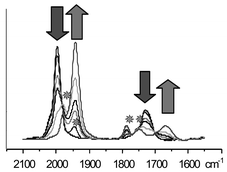The redox properties of some cluster complexes with a facial cyclooctatetraene (cot) ligand were investigated using electrochemical and IR spectroelectrochemical techniques. Reduction of [Co4(CO)3(μ3-CO)3(μ3-C8H8)L2]
1
(L2
=
η4-C8H8), 2
(L2
=
η4-C6H8), and 3
(L2
=
η4-6,6-Ph2C6H4) occurs in CH2Cl2 or THF solution in two consecutive one-electron electrochemically reversible steps. Both one- and two-electron primary reduction products are unstable on a longer timescale; eventually degradation (decapitation) of the tetranuclear clusters takes place, to give the stable anion [Co3(CO)3(μ-CO)3(μ3-C8H8)]−5. The electronic structure of 1, 2, the octacarbonyl derivative [Co4(CO)5(μ3-CO)3(μ3-C8H8)]
4, their monoanions, dianions and 5 was investigated using ab initio DFT MO calculations. The calculations showed the monoanions to be relatively stable compared to the neutral parent clusters, the relative stability depending on the type of apical ligand and reflecting its bonding capabilities, namely the possibility of ring slippage for a cot ring. Hence, an η4
→
η2 haptotropic shift of the apical C8H8 ring is calculated to occur during the reduction of 1 to give the dianion [1]2−. In marked contrast, in complex 4 the haptotropic shift involves the facial, η8-coordinated cot, which is pushed into an η6-coordination in the optimized structure of the two-electron reduction product [4]2−. In all the cases studied, the second reduction step is however not favored energetically and reinforces the structural and electronic effects caused by the first reduction. The observed decapitation of the anionic tetranuclear cluster complexes can be traced to an ubiquitous weakening of the Coapical–Cobasal bonds.

You have access to this article
 Please wait while we load your content...
Something went wrong. Try again?
Please wait while we load your content...
Something went wrong. Try again?


 Please wait while we load your content...
Please wait while we load your content...